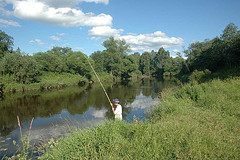What Makes Fly Fishing Special
Fly fishing is a special approach to angling. Fly fishing is different from bait-casting or spin-casting because fly fishing uses a weighted line to carry the nearly weightless lure forward when casting. conventional fishing tackle is designed to have a nearly weightless line transported by weighted bait on the end. Because of this important difference fly fishing has its own gear, equipment and terms.
Fly fishing also requires a few different techniques than conventional fishing. Traditional fishing might involve casting a baited hook and waiting for the fish to bite or even casting and retrieving the baited hook. However, fly fishing involves casting repeatedly along with brief pauses to allow the particular fly to float in the current.
Fly fishing rods are different compared to traditional fishing rods in several ways. Fly fishing rods are usually longer than most angling rods with their length regularly between six and 9 feet. Some fly fishing rods are even longer than 9 feet, particularly those fishing rods designed for salmon or steelhead fishing.
Fly fishing reels vary from traditional fishing reels as well. Fly fishing actually does not need much use of the reel. earlier fly fishing reels were little more than storage space for the collection. Fish are not reeled within when caught; rather, the particular angler strips line with his or her free hands. Many fly reels nevertheless are very primitive with styles very similar to those used in the particular 19th century.
Fly fishing collection is quite different from traditional angling line. While traditional angling line is made of a clear, monofilament material, fly fishing line will be comparatively heavy and clear. Fly fishing line may be designed to float or to sink depending on the style of fishing it is intended for; the line also may be pointed or level, again depending on the type of fishing that is prepared and the preference of the fisherman. Fly fishing line is available in various weights. Heavier line can be cast further and has higher wind-resistance than lighter collection. However, a lighter collection may provide for more exact casting by an experienced fisherman. Fly fishing line is normally close to 90 feet long yet may be attached to a dionysus to lengthen the overall collection available for fish that like to fight.
A leader is attached to the end of the fly fishing collection. The fly is tied to the end of the leader. The leader is a clear, monofilament collection normally between six plus fifteen feet in length. The leader is tapered to a narrow diameter an the end of the line.
Fly fishing is also unique because of the variety of fishing possibilities it provides. Fly fishing techniques can be used on streams, rivers, fish ponds and lakes. Fly fishing functions in salt water and fresh water, cold water and warm water. Fly fishing can open up numerous opportunities to fish new oceans because the techniques and gear are so adaptable.
Fly fishing consists of an interesting history that stretches back at least to the 2nd century. Macedonian fishermen effectively used artificial flies upon six-foot poles to capture fish with. Fly fishing recognition increased in 19th hundred years England and Scotland prior to catching on in the United States.
Fly fishing is a historically interesting, challenging approach to fishing. Fly fishing offers numerous opportunities and variations in order to anglers. Fly fishing also includes the nostalgic element that may not be found with other fishing designs.

